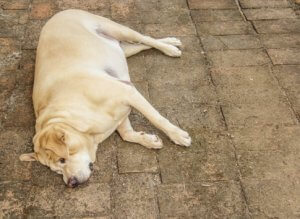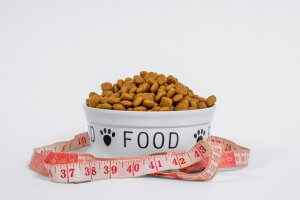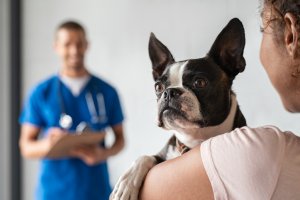 Separation anxiety is sued to describe dogs that are overly attached or dependent on family members. They will become extremely anxious and show distress when separated from their owner in ways such as:
Separation anxiety is sued to describe dogs that are overly attached or dependent on family members. They will become extremely anxious and show distress when separated from their owner in ways such as:- Vocalization
- Destruction
- House soiling
 Separation anxiety is sued to describe dogs that are overly attached or dependent on family members. They will become extremely anxious and show distress when separated from their owner in ways such as:
Separation anxiety is sued to describe dogs that are overly attached or dependent on family members. They will become extremely anxious and show distress when separated from their owner in ways such as: The body conditioning score or BCS is a way of evaluating your dog’s body fat. Once your veterinarian has visualized and palpated your pet, they will assign your pet a score from one to 9. One is extremely emaciated, and nine is extremely obese. Scoring is as follows:
The body conditioning score or BCS is a way of evaluating your dog’s body fat. Once your veterinarian has visualized and palpated your pet, they will assign your pet a score from one to 9. One is extremely emaciated, and nine is extremely obese. Scoring is as follows: While you may think the label on your dog’s food for recommended food amounts is accurate, they are actually just estimates, and they typically overestimate your dog’s food needs. The general estimates on your dog’s food bag do not consider your dog’s individual needs, which are based on breed, age, activity level, weight, and whether they are spayed or neutered.
While you may think the label on your dog’s food for recommended food amounts is accurate, they are actually just estimates, and they typically overestimate your dog’s food needs. The general estimates on your dog’s food bag do not consider your dog’s individual needs, which are based on breed, age, activity level, weight, and whether they are spayed or neutered. Your dog is not naturally comfortable with their ears, belly, feet, or nails being touched, so they need time to get comfortable. Take time each day to practice these actions with your pet. This will help them get accustomed to these actions and make them more at ease when they go to the veterinarian.
Your dog is not naturally comfortable with their ears, belly, feet, or nails being touched, so they need time to get comfortable. Take time each day to practice these actions with your pet. This will help them get accustomed to these actions and make them more at ease when they go to the veterinarian.Let Your Dog Exercise
Avoid Petting Your Dog
Bring Along Their Favorite Treats
 Your pet reacts differently to allergies than humans do and will often show skin irritation. Here are some signs your pet may be suffering from an allergy:
Your pet reacts differently to allergies than humans do and will often show skin irritation. Here are some signs your pet may be suffering from an allergy:If you plan to be traveling with your pet this summer, the Animal Medical Center of Streetsboro has put together some tips and tricks to help keep traveling with your pet safe and stress-free.
 No matter where you are traveling to or how you travel there, you need to make sure your pet is microchipped for identification. You also want to make sure that your pet is wearing their collar with your name, phone number, and any other relevant contact information.
No matter where you are traveling to or how you travel there, you need to make sure your pet is microchipped for identification. You also want to make sure that your pet is wearing their collar with your name, phone number, and any other relevant contact information.
We also recommend that you place a temporary tag on their collar with your destination phone number and cell phone number for the length of your trip.
Unless your pet is small enough to ride underneath your seat, we recommend avoiding air travel with your pets. If it is necessary to bring them along while flying, you will want to follow these tips:
Before your trip, we recommend that you make an appointment for a routine checkup for your pet. This will ensure they are updated on all vaccinations and will allow you to obtain a health certificate from your veterinarian that will be dated within ten days of your trip.
During this appointment, our veterinarian can discuss ways that you can calm your pet before the flight in case they become anxious or afraid. If you are traveling outside of the U.S., be sure to check with the foreign office of the country where you are traveling for any additional planning or health care requirements.
 Make sure the crate is large enough for your pet to comfortably stand, sit, and turn around. You will also need to place some type of bedding in the crate, such as towels or shredded paper, to absorb any accidents.
Make sure the crate is large enough for your pet to comfortably stand, sit, and turn around. You will also need to place some type of bedding in the crate, such as towels or shredded paper, to absorb any accidents.
You also want to tape a plastic bag of dried food into the crate, which will allow airline staff to feed your pet in case of a layover. You should also freeze a small water dish full of water. This will thaw out by the time they are thirsty during the flight. Keep the door securely closed, but do not lock it. Airline personnel needs to be able to access the crate if there is an emergency.
You also want to make sure the crate has proper identification. Be sure to make the crate with the words “Live Animal.” We also recommend you put your name, a photo of your pet, as well as your cell phone and destination phone number. We also recommend you keep a photo of your pet on hand while traveling in case they escape their crate.
Whenever possible, we recommend you book a direct flight when traveling with your pet. With a direct flight, you can reduce the chances that your pet is left on the tarmac during extreme weather or is mishandled by baggage staff during a layover.
If you are driving a long distance, there is more to traveling with your pet than just loading them into your backseat. Here are some tips to help you keep your pet safe out on the road:
Before a long trip, start by taking your pet on short drives and gradually increase the time they spend in the car. If you plan to travel across state lines, make sure you have your pet’s rabies vaccination record, as some states require proof at their interstate crossings.
Make sure the crate is large enough for the pet to stand, sit, and lie down. They should also be able to turn around in the crate. Secure the crate in the vehicle, so it doesn’t move when driving or coming to an abrupt stop. If you choose not to crate them, make sure your pet is secure by attaching their harness to the seat buckle. Do not allow them to ride with their head outside the window, as this could lead to injury.
Pack Your Pet a Travel Kit
When packing for your pet, make sure that you have a bowl, leash, food, waste bags and a scoop, medications, first aid, grooming supplies, and any important travel documents. You should also make sure to pack their favorite toy, blanket, or pillow. We recommend starting their feeding schedule a few hours prior to leaving with a light meal. Make sure to only give your pet bottled water as water from an unfamiliar area could cause an upset stomach.
Even if you leave the windows open, a vehicle can become as hot as a furnace on a hot day. When it comes to cold weather, the car can become like a freezer. Don’t put your pet at risk of heat stroke or freezing to death by leaving them in your vehicle unattended.
At the Animal Medical Center of Streetsboro, we can help you prepare your pet for travel. Contact us today to learn more!
When you get a new puppy, there are various things you need to do, from puppy-proofing your house to getting them their shots. In addition, you also need to make sure that your spay or neuter your pet to keep them healthy. Having your pet spayed or neutered can prevent various health issues, lower their risk for cancer, and overall increase their lifespan.
 Spaying, also called ovariohysterectomy, is a surgical procedure where the ovaries and uterus are removed to sterilize a female dog. This will prevent the dog from being able to reproduce.
Spaying, also called ovariohysterectomy, is a surgical procedure where the ovaries and uterus are removed to sterilize a female dog. This will prevent the dog from being able to reproduce.
For female dogs that weigh less than 45lbs, it is recommended that you spay them at 8 months of age. Female dogs weighing more than 45lbs should be spayed at 8-18 months depending on breed and mature size.
When you spay your dog, you can prevent unwanted litters and lower the dog’s risk of breast cancer.
If you spay them after growth stops, but after their first heat cycle, there is an increased risk of breast cancer and a decreased risk of certain cancers as well as bone, ligament, and joint problems. It can also lower the risk of urinary incontinence.
Neutering, also called castration, is a surgical procedure where both testicles are removed. This procedure sterilizes or makes the dog infertile and stops its ability to reproduce.
For male dogs that weigh less than 45lbs, it is recommended that you neuter them at 8 months of age. Male dogs weighing more than 45lbs should be neutered at 8-18 months depending on breed and mature size.
When you neuter your dog at the recommended age, you may decrease the risk of certain cancers and bone, ligament, and joint issues common in some male dog breeds.
We recommend speaking with your veterinarian at the Animal Medical Center of Streetsboro today to determine the best time to spay or neuter your puppy! Contact us to learn more.
 You will also notice itchy skin with food allergies. Dogs will typically itch their paws or ears and may experience gastrointestinal symptoms with a food allergy. When it comes to environmental allergens such as mold, pollen, or dust, your dog may suffer from an atopic allergic reaction or dermatitis. Typically, these are seasonal allergic reactions where you may notice your dog itching their paws, ears, ankles, muzzle, underarms, around the eyes, etc.
You will also notice itchy skin with food allergies. Dogs will typically itch their paws or ears and may experience gastrointestinal symptoms with a food allergy. When it comes to environmental allergens such as mold, pollen, or dust, your dog may suffer from an atopic allergic reaction or dermatitis. Typically, these are seasonal allergic reactions where you may notice your dog itching their paws, ears, ankles, muzzle, underarms, around the eyes, etc. The holidays are full of tasty treats for humans, but many of them can be harmful to your pet. If you plan to give your pet treats over the holidays, make sure that they are formulated just for them. Some common holiday foods to avoid:
The holidays are full of tasty treats for humans, but many of them can be harmful to your pet. If you plan to give your pet treats over the holidays, make sure that they are formulated just for them. Some common holiday foods to avoid:Table of contents:
Adding a new puppy to your family can be an exciting moment. If you ask any dog owner, they will agree that having a loyal companion that loves them unconditionally brings great joy to their daily lives. While it is a fun and exciting experience, having a dog is a significant commitment and a decision that should not be taken lightly.
If you are a first-time dog owner, you need to know a variety of things before bringing your new pet home.
Before you bring your new pet home for the first time, there are a few things you will want to do to your home to help make it safer and more comfortable for your new pet.
Now that you’ve gathered all the necessary supplies for your dog, it’s important to evaluate your home and eliminate any hazards. You will need to go throughout the home and dog-proof everything. Start by tucking or taping any loose electrical cords to baseboards.
You also want to make sure any household cleaners are stored on high shelves or secured in cabinets. You should also move any small rugs, pack up your breakable items or place them up out of reach as your puppy navigates its new home. Make sure you have the gates set up as well as their crate. Set up their food and water dishes as well.
As you secure your home, you will also want to decide where your dog will spend most of its time. If you are working from home, you can take your dog out at regular intervals and supervise them. If you need to leave your dog at home alone, you need to decide if they will be crated indoors with a neighbor or friend taking them out for bathroom breaks or if they will spend their time in an exercise pen.
You should also research pet daycare pricing to see if that is an option for you. Be sure to determine which options are best for your dog and have arrangements in place before you bring your pet home. You also need to decide where the dog will sleep each night. You can have them in a crate in your room, give them their bed as they get older, or maybe even allow them to sleep in bed with you or another family member in the home. You may also decide to let them roam freely throughout the home at night once they have been potty trained.
When looking for a veterinarian, you can start by asking your friends or family for recommendations. Once you’ve found a few that you are interested in, take the time to visit the different offices and meet with the veterinarian and staff to get a better idea of what they are like. You should also ask for a tour of the facility to make sure that you are comfortable with their standards of cleanliness. Make a checklist of what matters to you most regarding veterinarian care, and make sure you look for those qualities as you do your research.
It’s crucial for your puppy’s first vet visit to be a good experience so your dog can learn to go to the vet without anxiety or fear. Once you’ve chosen a vet, schedule your dog’s first appointment so they can get a checkup and any vaccinations they may need.
In most places in the United States, it is legally required that you have a dog license. Your local law may be different, but a dog tag will help return them home if they ever get lost. You can also have your dog microchipped for additional insurance. Call your local animal care and control to learn more about how to get your dog licensed. In many cases, you should be able to apply online.
When you first bring your dog home, keep things calm and laid back. Try not to overwhelm your puppy with a bunch of visitors and let them settle in for the first few days. You should also introduce your dog to their crate so you can get started on crate training. This is a great method for house training. The crate should be large enough for your puppy to stand up and turn around easily but not so roomy they can go to the bathroom on one side and lay on the other.
Another helpful tip is to put a toy stuffed with treats in the crate and close the door. When your dog starts to sniff and paw at the crate, you can open the door, let them inside, and close the door. Give your dog about 10 to 15 seconds in the crate with the door closed and then remove the treats and close the door again. Reopen the crate, place the treats back in and repeat the process. This should be repeated three to four times in a row at least four times throughout the day.
Training your pup should start as soon as you bring them home. The earlier you train them with good habits, the easier and faster they will learn good manners. This will help them learn what they can and cannot do, where their water and food dishes are, where they are supposed to go to the bathroom, which toys are theirs, where they can and cannot go in the house, and what behaviors are restricted.
When researching trainers, look for one who shares the same ethics and philosophy about dog training. You will want to make sure that they use methods you support to ensure that you will carry the training at home. You can expect to be a part of the trainer process and work with the trainer closely to reinforce the skills at home.
Consider getting recommendations from friends and neighbors. You will also want to make sure your trainer is certified and that they have references they can give you from current or previous clients.
To keep your dog in good health, you will want to take your puppy to the vet for a checkup every three to four weeks until they reach 16 weeks old. During these checkups, they will receive their vaccines as well as heartworm and flea/tick medication. The vet will make sure your dog is growing normally and that they are healthy. At six months old, you will schedule your dog to be neutered or spayed. As your dog gets older, your veterinarian will be able to recommend a schedule for a visit to make sure your pet gets the exams and shots they need.
Another important part of their health is keeping a regular exercise schedule—the amount of exercise your pet needs will depend on their age, size, and breed. Get into the habit of exercising your dog around the same time of day for a consistent amount of time to keep them happy and healthy. Walking, running, or playing fetch are all great ways for your dog to exercise.
There are various dog food types and brands out there, from soft to kibble (dry food), each with its benefits and drawbacks.
Canned/wet food – Canned dog food is shelf-stable and makes for a convenient food option for dog owners. Keep in mind that this type of food is not always nutritionally complete and can also be expensive. Look for canned food that is “100% nutritionally complete.”
Kibble/dry food – This is one of the most affordable options and helps with your dog’s oral health because chewing the crunchy kibble helps remove tartar.
Semi-moist – This food resembles “meaty food” and is commonly made up of preservatives as well as artificial colorings and flavors with little nutritional value. These are usually best suited as an occasional treat for your pup.
Raw – This diet comprises raw bones, raw meat, fruit, vegetables, and raw organs. This type of diet can be great for dogs, but it has its drawbacks. It can be time-consuming to prepare, poses a risk of imbalances in nutrition and the risk of broken teeth. Speak with your veterinarian before switching to this diet.
Veterinary diet – This is a diet specifically formulated to address your dog’s specific health needs for certain types of conditions. Your vet will recommend this type of diet if needed.
When choosing food for your dog, be sure to focus on the first five ingredients of the food. You also want to look for food with top-quality digestible proteins. Avoid foods with ingredients such as poultry or meat by-products, generic fat sources like animal fat, artificial colors, flavors, preservatives, and added sweeteners.
The amount of food and how often you feed your dog will depend on their size and how much exercise they get each day. You want to avoid overfeeding your dog. This can lead to skin disorders, oral disease, heart disease, musculoskeletal problems, skin disorders, arthritis, diabetes, and even some types of cancer.